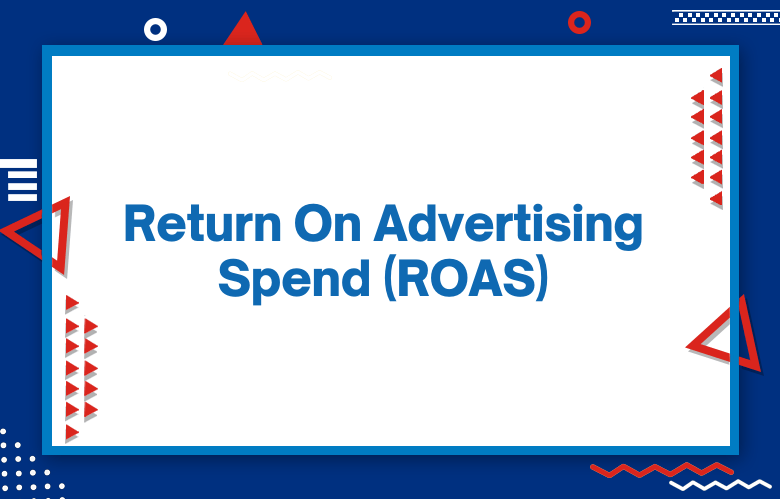What is Return On Advertising Spend: How to calculate your ROAS

You should always be concerned with the ROI of your advertising. Whether it’s TV, radio, or digital ads, there are ways to measure the effectiveness and value of each type. This post will explore how to do that to better understand where your money is going.
This post explores how brands can track their advertising spend to know what’s working and what isn’t regarding ROI.
In this blog post, we’ll look at: – How Brands Can Track Their Advertising Spend; – Which Marketing Channels Are The Best For Tracking Return On Investment, And – What To Look For When Analyzing Data So You Know Where Your Money Is Going Back Into Your Business!
Every business today faces a common problem: ROAS, or Return on Advertising Spend. Do you know what it means? This is the ratio of your advertising spending to revenue, which can be used to measure how much money you are generating from your marketing efforts.
If you have an advertising budget but don’t know how to use it properly, this article will give you tips for improving ROAS that will work regardless of your industry.
What is the ROI on your advertising spend? It’s a question that every company has to ask themselves. If you’re not tracking it, then you’re missing out on some of the best insights about how your marketing dollars are being spent. In this blog post, we’ll show you how to calculate ROAS for any campaign and why it’s particularly essential for ad campaigns.
What is ROAS, and how does it work
Return on Ad Spend (ROAS) measures an ad campaign’s effectiveness. It’s calculated by dividing ad revenue by total advertising costs and multiplying the result by 100%.
ROAS is a metric that represents the return on ad spend. It measures the actual sales generated by an ad campaign divided by the total costs of the campaign, including advertising expenses and product costs.
Return on advertising spend (ROAS) is a marketing metric measuring the revenue generated from a single dollar of ad spend.
What is ROAS
Return on Ad Spend (ROAS) is a metric that measures how effective your ads are at driving incremental revenue.
That’s a great question! ROAS is known as “return on ad spend.” It measures how profitable your marketing campaigns are.
Return on Ad Spend is a performance metric that measures the revenue gained from an ad relative to its cost.
ROAS stands for ROI on Ad Spend. It measures the profitability of your advertising campaigns, telling you how much money each dollar spent brings in. In other words, it measures the return on investment (ROI).
Why should I care about ROAS?
We should all care about ROAS. It’s a way to indirectly calculate your ad campaigns’ effectiveness by measuring return on investment.
Investing in Return on Ad Spend (ROAS) is one of the best things you can do for your business. It lets you measure your marketing efforts’ profitability and allows you to improve them over time.
- The revenue per user number tells you how much each customer is worth in terms of sales.
- ROAS is a crucial metric to watch because it helps you calculate whether your ads are profitable.
- ROAS is a great way to measure the effectiveness of your ad campaigns.
Examples of ROAS in action
A great example of ROAS is the “Duck Test,” which states that if a business owner has many ducks, he or she is likely making a lot of money.
For example, if you invest $1k in a new ad campaign and generate a return of $300 over the next month. This would be a ROAS of 300%.
In 2006, Wal-Mart saw the light and started selling organic foods. Three years later, their organic food sales were $1 billion annually.
ROAS is one of the essential analytics metrics. If you’re still not sure what this stands for, read on!
The benefits of a high ROAS
The benefit of a high ROAS is that you can get more customers, which means your revenue will go up.
The ROAS is the amount of money you generate for every dollar spent. It’s a measure of whether your campaign was successful.
The key to improving ROAS is through strategic retargeting.
The drawbacks of a low or negative ROAS
That’s the end of my presentation on ROAS. I hope you found it informative!
It’s frustrating to work hard on a campaign only to discover that it doesn’t perform as well as expected.
A low or negative ROAS is a sign of poor campaign management.
The most significant thing to remember is that a low or negative ROAS can be positive in the long run. A ROAS of -0.01 doesn’t seem like much, but if you continue increasing, it becomes +1.00 over time.
A low ROAS isn’t the end of the world, and it’s not like you can never have one. It means a few things need to be done better.
Why should you care about ROAS?
Understanding ROAS is necessary for any business owner, and it’s not hard to learn.
Return on Ad Spend is a critical factor that marketers should understand and focus on. It’s the return you get from investing your ad spend over the lifetime of your campaign.
Return on Ad Spend (ROAS) is an essential metric in marketing. It measures how much revenue a company generates with an advertising campaign compared to its cost.
How to calculate your ROAS
ROAS, or return on ad spend, compares the profitability of different advertising campaigns. It can help you determine which ads work best and how much to invest in new campaigns.
Your Return on Ad Spend is the amount you spent divided by the number of sales you made. For example, if you paid $10 and got ten deals, your ROAS would be $1.
There are multiple ways to calculate your ROAS, but the easiest is probably using Google Sheets.
ROAS stands for Return On Advertising Spend. It measures the profitability of the profitability of your ad campaigns and is essential to track regularly.
Return on advertising spend (ROAS) is a financial ratio that measures the profitability of an ad campaign. It reminds you how much money you made relative to the advertising spend.
You should know that ROAS is short for Return On Advertising Spend. To calculate your return on advertising spends, you need to divide the revenue generated from ads by the amount of ad money spent in a period divided by one thousand.
Calculating your Return on Advertising Spend (ROAS) is a great way to see how effectively you drive traffic to your site.
When should you be concerned about your ROAS?
ROAS stands for Return on Advertising Spending, an important measurement to be aware of as an entrepreneur. However, it’s not the most accurate way to evaluate your business. I recommend using LTV instead.
If you’re looking to measure the business quickly, the answer is simple: increase your ROAS.
If your ROAS is less than $1.50, you should be concerned because that’s below the average ROAS for e-commerce businesses.
If your ROAS has been harmful for an extended period, you should be concerned. It means you are losing money, and unless something changes, you’ll lose even more over the next few months.
If you’re not making money from your advertising, the first thing to do is check your return on ad spend (ROAS). You can also use ROI, but that’s more for financial reports than anything else.
The future of advertising and the impact on ROAS
In the present day, there is a clear connection between ROAS and advertising. However, as technology advances in the future, we should expect this link to weaken because marketing campaigns will fine-tune ads to such a degree.
The future will be digital advertising. We’ll see an increase in mobile devices and a decrease in traditional media (TV). Companies need to work harder than ever to reach their target audience effectively.
Businesses will be moving towards a more data-driven approach to marketing and advertising. This change in strategy will allow companies to improve their Return On Ad Spend (ROAS)
In the era of social media, businesses are looking for new ways to advertise their products. In this article, we’ll discuss how companies use streaming video ads on Facebook to increase ROAS.
According to a recent study, the top 5% of ad spenders get 50x more clicks. This indicates that advertising in 2018 will be based on results and not impressions.
Tips for improving your company’s ROAS – (e-commerce, direct marketing, etc.)
One of the best ways to increase profits is by improving ROAS. Focusing on optimizing your business’s acquisition channel and customer lifetime value can help.
The best way to increase your ROAS is to optimize, automate, and make more sales. For example, if you have a high conversion rate on your website but don’t know why, test out different designs.
The best way to improve your company’s ROAS is to eliminate the costs that don’t produce a return.
Return On Advertising Spend Strategies
- Determine your budget and advertising channels
- Set a return on investment goal for your campaign, then divide it by the number of potential customers to figure out how much you need to spend per customer.
- Evaluate different marketing tactics- TV ads are expensive but can be very effective if targeted at the right audience; print ads may be less costly than TV or radio but have a lower reach.
- Consider whether you want a short-term spike in traffic or sustained growth over time when planning your strategy.
- Understand your goals
- Get to know the metrics of your business and how you can measure ROAS
- Set a budget for advertising spend that aligns with your goals, traffic, and competition
- Determine which channels will best suit your needs- eCommerce stores should focus on Google Shopping ads or Facebook Ads, while brick-and-mortar retailers might want to try Instagram or Snapchat campaigns
- Choose an ad attribution model (last click vs. the first click) that suits your strategy and marketing data
- Test out different creatives to find what resonates well with customers and optimize accordingly
- Develop a strategy for the type of customer you want to attract
- Calculate your Return On Advertising Spend (ROAS) by dividing the sales generated by advertising spend
- Determine which channels are performing well and which need improvement
- Create a ROAS goal based on what you hope to achieve with your marketing efforts
- Determine your advertising budget
- Set a monthly advertising goal for how much you want to spend on ads and the return on that investment.
- Calculate ROAS by dividing your total revenue from ad spending by the cost of those ads (ROAS = Total Revenue ÷ Advertising Cost)
- Find out which media channel is most effective for you, such as Facebook, Google Adwords, or YouTube Ads.
- Choose an advertising platform and set up an account to create and run ads within that platform’s interface.
- Create a campaign with specific goals like boosting conversion rate or increasing brand awareness.
- Track all of your campaigns using analytics tools.
- Select the most relevant advertising channels for your business
- Set a budget and calculate ROAS to make sure you are getting a return on investment
- Evaluate the performance of each channel against your target audience, product, and service offerings
- Determine which channels work best for you based on these evaluations
1) Optimize your website for conversion
2) Use a variety of ad formats to reach different audiences
3) Test and measure the impact of your ads on business goals - Understand your ROAS
- Know what you want to gain with your advertising campaign
- Find out how much you can spend on advertising without affecting the business or yourself financially
- Decide if you want a short-term or long-term strategy for your ROAS
- Determine the return on ad spend of your current advertising campaigns
- Analyze what is not working about those campaigns and make changes to increase ROAS
- Investigate new ad platforms that you may have overlooked, like Instagram or Pinterest
- Evaluate the effectiveness of your ads by looking at metrics such as click-through rate, conversion rates, and cost per acquisition
-Identify key performance indicators for your business
-Measure ROI on every campaign you run
-Work with an agency to develop a strategic marketing plan that includes measurable goals
-Focus on the customer, not just sales or revenue. The more customers you have, the higher your chance of future sales. - Advertise on social media channels like Facebook, Instagram, and Twitter
- Create a blog with content relevant to your business
- Use Google Adwords or Bing Ads to advertise in search engines
- Sponsor a podcast or vlogger by paying them for their time
Conclusion
Return on Advertising Spend (ROAS) is an important metric to consider when evaluating the effectiveness of your marketing campaigns. ROAS measures how much revenue a company generates for every dollar spent on advertising.
It can be calculated by dividing the total sales generated from ads in a given period by ad spending. It’s not just about looking at the number of clicks or impressions; you want to know what kind of return those efforts generate for your business. If you’re interested in calculating ROAS, we have some helpful tools available here!
In conclusion, ROAS can be calculated by dividing the total revenue generated from your advertising spend by the cost of the same media. The higher your ROAS, the better you invest resources and money into marketing to generate sales.
Suppose you’re looking for a way to calculate your return on investment in digital campaigns; contact us today! We have experts ready to help you start figuring out how much money you made through online ads compared to what was spent on those advertisements.
One of the most important metrics to track is Return On Advertising Spending (ROAS). This can be measured by dividing total revenue from advertising spending by marketing spending.
The higher this number is, the more profitable your digital ads investment will be. There’s no need for guesswork when tracking ROAS because we offer a free monthly calculation on our dashboard so that you’ll know how much money each ad campaign is making with just a glance at the numbers!
If you’re looking for help calculating these figures yourself, please get in touch with us anytime! We would love to show off some examples of what we’ve done for other businesses like yours and have an opportunity to discuss any questions or concerns you may have.
Contact us if you wish to find more information about our services or have any other questions concerning digital marketing strategies for eCommerce companies.”
Call: +91 9848321284
Email: [email protected]



